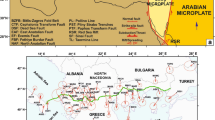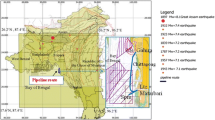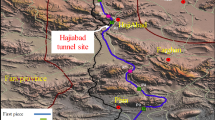Abstract
A comprehensive seismic risk assessment has been performed for the existing route of the 3rd Azerbaijan natural gas buried pipeline in Iran. The major active seismic sources along the pipeline were identified and the geometrical parameters as well as the seismicity rates were determined. The seismic hazard assessment of the ground vibrations along the pipeline was performed in the framework of the Probabilistic Seismic Hazard Analysis using the CRISIS 2007 software. All of the components of the gas pipeline along the route were identified and the corresponding fragility functions are established through the methodology described in the HAZUS guideline (HAZUS MH MR4 Technical manual 2007 Department of homeland security emergency. Preparedness and Response Directorate, FEMA). A detailed cost analyses was taken into consideration based on the expert opinions in the National Iranian Gas Company, in order to provide more practical loss model for the pipeline route. Also, a simple method is suggested in order to account for the vent gas in the total loss estimation. The spatial analysis of the hazard function layer in combination with the loss model layer, in Geographical Information System (GIS) platform, reveal the financial consequences of different earthquake scenarios.













Similar content being viewed by others
References
Abrahamson N, Silva W (2008) Summary of the Abrahamson & Silva NGA ground motion relations. Earthq Spectra 24(1):67–97
Akkar S, Bommer JJ (2010) Empirical equations for the prediction of PGA, PGV and spectral accelerations in Europe, the Mediterranean Region and the Middle East. Seismol Res Lett 81(2):195–206
Berberian M (1976) Contribution to the Seismotectonic of Iran (Part II). Minist Ind Mines 39:570
Berberian M (1994) Natural hazards and the first earthquake catalogue of Iran: historical hazards in Iran prior to 1900. International Institute of Earthquake Engineering and Seismology (IIEES). Report No. 1:620
Boore D, Atkinson G (2008) Ground motion prediction equations for the average horizontal component of PGA, PGV, and 5%-damped PSA at spectral periods between 0.01 s and 10.0 s. Earthq Spectra 24(1):99–138
Chang SE, Shinozuka M, Moore JE (2000) Probabilistic earthquake scenarios: extending risk analysis methodologies to spatially distributed systems. Earthq Spectra 16(3):557–572
Chiou BS, Youngs RR (2008) An NGA model for the average horizontal component of peak ground motion and response spectra. Earthq Spectra 24(1):173–215
Decò A, Frangopol DM (2013) Life-cycle risk assessment of spatially distributed aging bridges under seismic and traffic hazards. Earthq Spectra 29(1):127–153
Ghasemi H, Zare M, Fukushima Y, Koketsu K (2009) An empirical spectral ground-motion model for Iran. J Seismol. doi:10.1007/s10950-008-9143-x
Hazus MH MR4 Technical Manual (2007) Department of homeland security emergency. Preparedness and Response Directorate, FEMA
Honegger DG, Eguchi RT (1992) Determination of the relative vulnerabilities to Seismic damage for San Diego county water Authority (SDCWA). Water Transmission Pipelines 992
Hwang H, Chiu Y, Chen W, Shih B (2004) Analysis of damage to steel gas pipelines caused by ground shaking effects during the Chi–Chi, Taiwan, earthquake. Earthq Spectra 20(4):1095–1110. doi:10.1193/1.1811615
Jayaram N, Baker JW (2009) Correlation model for spatially distributed ground-motion intensities. Earthq Eng Struct Dyn 38:1687–1708
Kalkan E, Gülkan P (2004) Site-dependent spectra derived from ground motion records in Turkey. Earthq Spectra 20(4):1111–1138
Karamitros DK, Bouckovalas GD, Kouretzis GP (2007) Stress analysis of buried steel pipelines at strike-slip fault crossings. Soil Dyn Earthq Eng 27:200–211
Koike T, Takada S, Ogawa Y, Matsumoto M, Tajima T, Hassani N (2004) Seismic damage predictions for the gas distribution systems in great Tehran, Iran. 13th World Conference on Earthquake Engineering, Vancouver, B.C., Canada, paper no. 3394
Komakpanah A, Farajzadeh M (1995) Macrozonation of liquefaction susceptibility and opportunity of Iran. In: Proceedings of the second international conference on seismology and earthquake engineering, Tehran, Iran, pp 1399–1408
Lee R, Kiremidjian AS (2007) Uncertainty and correlation for loss assessment of spatially distributed systems. Earthq Spectra 23(4):743–770
Liao SS, Samson SC, Veneziano D, Whitman RV (1988) Regression models for evaluating liquefaction probability. J Geotec Eng 114(4):389–411
Mori S, Chiba K, Koike T (2012) Seismic performance analysis of the gas transmission pipeline in the 2011 great east Japan earthquake, 15th World Conference on Earthquake Engineering, Lisbon, Portugal, paper no. 1767
Mousavi M, Ansari A, Zafarani H, Azarbakht A (2012) Selection of ground motion prediction models for seismic hazard analysis in the Zagros region Iran. J Earthq Eng 16(8):1184–1207
Nowroozi AA (1976) Seismotectonic provinces of Iran. Bull Seismol Soc Am 66(4):1249–1276
O'Rourke M, Ayala G (1993) Pipeline damage due to wave propagation. J Geotec Eng 119(9):1490–1498
O'Rourke TD, Jeon SS, Toprak S, Cubrinovski M, Hughes M, Ballegooy S, Bouziou D (2014) Earthquake response of underground pipeline networks in christchurch, NZ. Earthq Spectra 30(1):183–204
Park J, Bazzurro P, Baker JW (2007) Modeling spatial correlation of ground motion intensity measures for regional seismic hazard and portfolio loss estimation. 10th International Conference on Application of Statistic and Probability in Civil Engineering (ICASP10), Tokyo, Japan
Portante EC, Folga S, Wulfkuhle G, Craig BA, Talaber LE (2009) New Madrid and Wabash valley Seismic study, simulating the impacts on natural gas transmission pipelines and downstream markets. Simulation Conference (WSC), Proceedings of the 2009 Winter, pp 2867–2878
Sadigh K, Egan JA, Youngs RR (1986) Specification of ground motion for seismic design of long period structures. Earthq Notes 57:13
Seed HB, Idriss IM (1982) Ground motions and soil liquefaction during earthquakes. Earthquake Engineering Research Institute, Oakland, California, Monograph Series, p 13
Sharma M (2009) Ground-motion prediction equations based on data from the Himalayan and Zagros regions. J Earthq Eng 13(8):1191–1210
Song J, Chang L (2008) Matrix-based system reliability analysis of urban infrastructure networks: a case study of MLGW natural gas network. Fifth China-Japan-US Trilateral Symposium on Lifeline Earthquake Engineering, http://hdl.handle.net/2142/5123
Stewart JP (2001) Chapter 4: Soil liquefaction. Chi–Chi, Taiwan, Earthquake of September 21, 1999, reconnaissance report, Uzarski J and Arnold C (eds). Earthq Spectra 17:37–60
Stocklin J (1968) Structural history and tectonics of Iran, a review. AAPG Bull 52(7):1229–1258
Takada S, Hassani N, Fukuda K (2001) A new proposal for simplified design of buried steel pipes crossing active faults. Earthq Eng Struct Dyn 30:1243–1257
Takin M (1972) Iranian geology and continental drift in the Middle East. Nature 235:147–150. doi:10.1038/235147a0
Talebian M, Jackson J (2004) A reappraisal of earthquake focal mechanisms and active shortening in the Zagros mountains of Iran. Geophys J Int 156:506–526
Tavakoli B, Ghafory-Ashtiany M (1999) Seismic hazard assessment of Iran. Ann Geophy vol 42(6). doi:10.4401/ag-3781
Toprak S, Taskin F (2007) Earthquake damages to buried pipelines caused by ground shaking. Nat Hazards 40(1):1–24
Toro G (2006) The effects of ground-motion uncertainty on seismic hazard results: examples and approximate results. Annual Meeting of the Seismo Seismological Society of America, San Francisco
Trifonov OV, Cherniy VP (2010) A semi-analytical approach to a nonlinear stress–strain analysis of buried steel pipelines crossing active faults. Soil Dyn Earthq Eng 30:1298–1308
Vazouras P, Karamanos SA, Dakoulas P (2012) Buried steel pipelines crossing strike-slip faults. In: Proceedings of the Twenty-second International Offshore and Polar Engineering Conference Rhodes, Greece, June 17–22, 2012
Wijewickreme D, Honegger D, Mitchell A, Fitzell T (2005) Seismic vulnerability assessment and retrofit of a major natural gas pipeline system: a case history. Earthq Spectra 21:539–567
Wong I, Bouadid J, Graf W, Huyck C, Porush A, Silva W, Siegel T, Bureau G, Eguchi R, Knight J (2005) Potential losses in a repeat of the 1886 Charleston, South Carolina, earthquake. Earthq Spectra 21(4):1157–1184
Xie L, Tao X, Wen R, Cui Z, Tang A (2000) A GIS based earthquake losses assessment and emergency response system for Daqing oil field. 12th World conference on earthquake engineering proceeding, paper no 91
Xie X, Symans MD, O’Rourke MJ, Abdoun TH, O’Rourke TD, Palmer MC, Stewart HE (2013) Numerical modeling of buried HDPE pipelines subjected to normal faulting: a case study. Earthq Spectra 29:609–632
Yamin L, Arambula S, Reyes J, Belage S, Vega Á, Gil W (2004) Earthquake loss estimation for a gas lifeline transportation system in Colombia. 13th World Conference on Earthquake Engineering, Vancouver, B.C., Canada, paper no. 2941
Zafarani H (2012) Simulation of strong ground motion in the Zagros region, Iran using the specific barrier model and stochastic method. Bull Seismol Soc Am 102(5):2031–2045. doi:10.1785/0120110315
Acknowledgments
The research conducted by the authors has been funded by the National Iranian Gas Transmission Company (NIGTC) under Grant Number 51097-110. This support is gratefully acknowledged. Any opinions, findings and conclusions or recommendations expressed in this material are those of the authors and do not necessarily reflect those of the funding body. The authors are also grateful to thank Mr. Amir Hosein Asgarian from NIGTC, who was the industrial advisor in this study.
Author information
Authors and Affiliations
Corresponding author
Rights and permissions
About this article
Cite this article
Mousavi, M., Hesari, M. & Azarbakht, A. Seismic risk assessment of the 3rd Azerbaijan gas pipeline in Iran. Nat Hazards 74, 1327–1348 (2014). https://doi.org/10.1007/s11069-014-1244-y
Received:
Accepted:
Published:
Issue Date:
DOI: https://doi.org/10.1007/s11069-014-1244-y




